MERCEDES-BENZ C-Class COUPE 2014 CL204 Owner's Manual
Manufacturer: MERCEDES-BENZ, Model Year: 2014, Model line: C-Class COUPE, Model: MERCEDES-BENZ C-Class COUPE 2014 CL204Pages: 342, PDF Size: 4.55 MB
Page 321 of 342
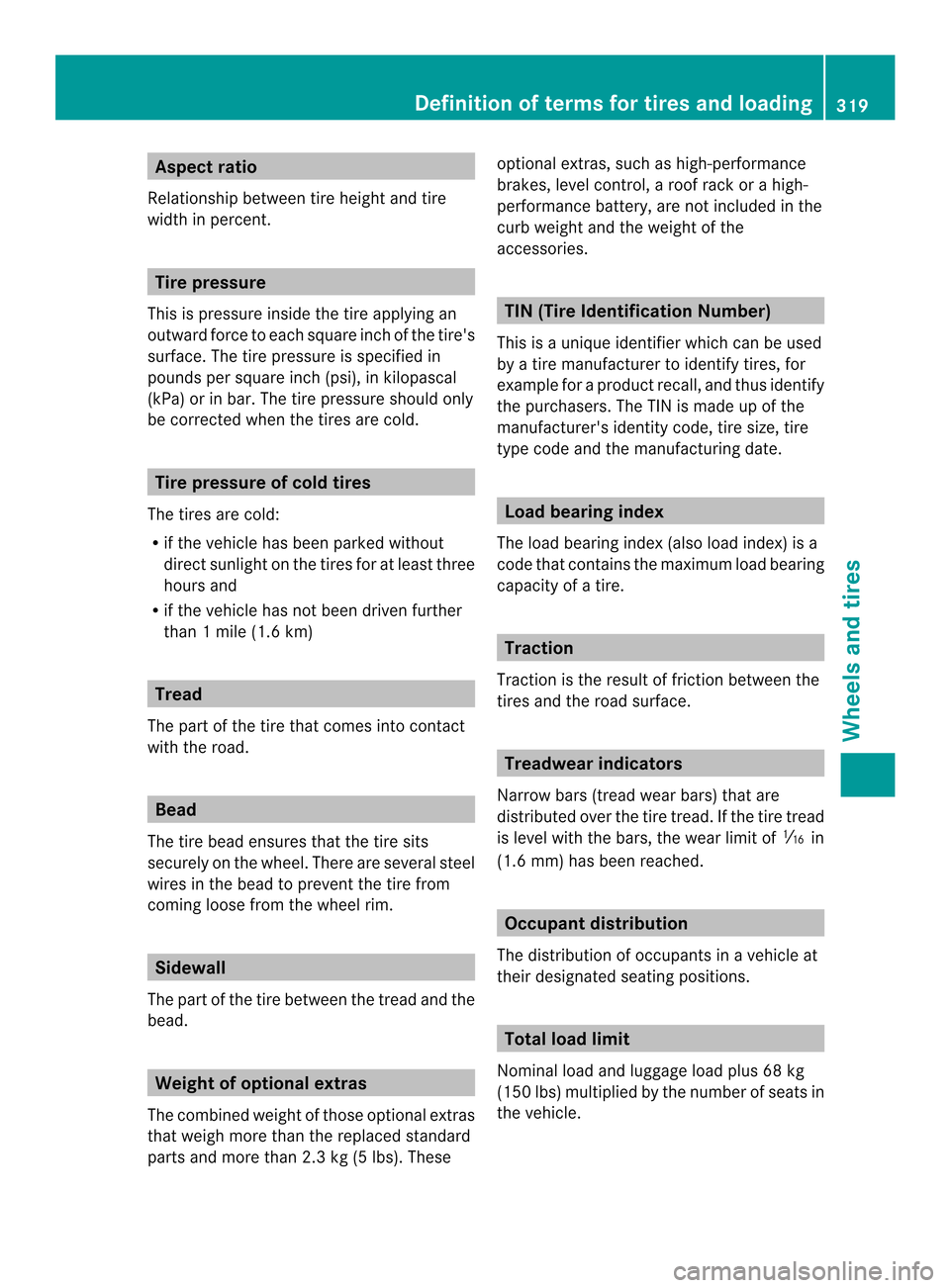
Aspect ratio
Relationship between tire height and tire
width in percent. Tire pressure
This is pressure inside the tire applying an
outward force to each square inch of the tire's
surface. The tire pressure is specified in
pounds per square inch (psi), in kilopascal
(kPa) or in bar. The tire pressure should only
be corrected when the tires are cold. Tire pressure of cold tires
The tires are cold:
R if the vehicle has been parked without
direct sunligh tonthe tires for at least three
hours and
R if the vehicle has not been driven further
than 1 mile (1.6 km) Tread
The part of the tire that comes into contact
with the road. Bead
The tire bead ensures that the tire sits
securely on the wheel. There are several steel
wires in the bead to prevent the tire from
coming loose from the wheel rim. Sidewall
The part of the tire between the tread and the
bead. Weight of optional extras
The combined weight of those optional extras
that weigh more than the replaced standard
parts and more than 2.3 kg (5 lbs). These optional extras, such as high-performance
brakes, level control, a roof rack or a high-
performance battery, are not included in the
curb weight and the weight of the
accessories.
TIN (Tire Identification Number)
This is a unique identifier which can be used
by a tire manufacturer to identify tires, for
example for a product recall, and thus identify
the purchasers. The TIN is made up of the
manufacturer's identity code, tire size, tire
type code and the manufacturing date. Load bearing index
The load bearing index (also load index) is a
code that contains the maximum load bearing
capacity of a tire. Traction
Traction is the result of friction between the
tires and the road surface. Treadwear indicators
Narrow bars (tread wear bars) that are
distributed over the tire tread. If the tire tread
is level with the bars, the wear limit of 0008in
(1.6 mm) has been reached. Occupant distribution
The distribution of occupants in a vehicle at
their designated seating positions. Total load limit
Nominal load and luggage load plus 68 kg
(150 lbs) multiplied by the number of seats in
the vehicle. Definition of terms for tires and loading
319Wheels and tires Z
Page 322 of 342
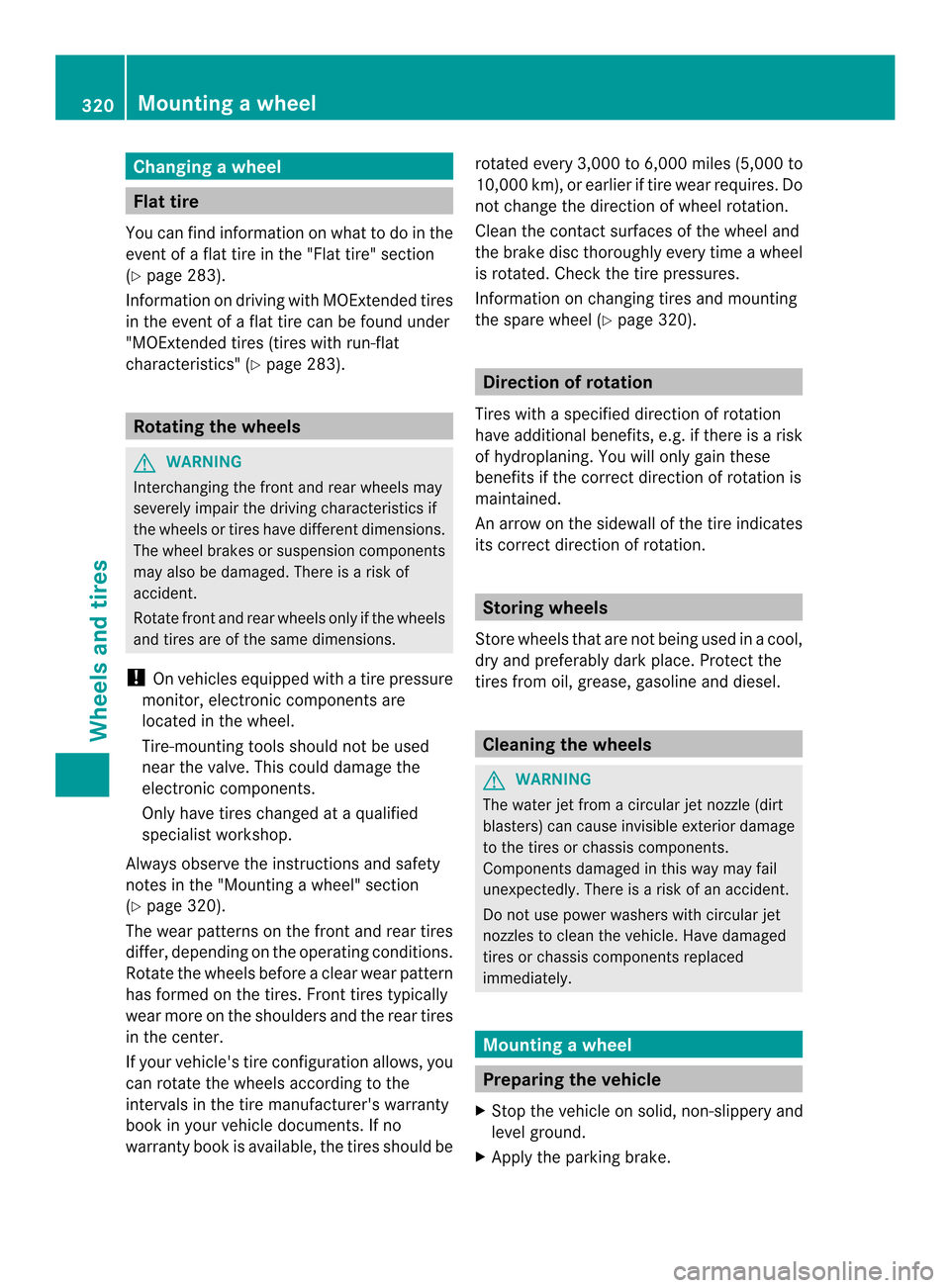
Changing
awheel Flat tire
You can find information on wha tto do in the
event of a flat tire in the "Flat tire" section
(Y page 283).
Information on driving with MOExtended tires
in the event of a flat tire can be found under
"MOExtended tires (tires with run-flat
characteristics" (Y page 283).Rotating the wheels
G
WARNING
Interchanging the front and rear wheels may
severely impair the driving characteristics if
the wheels or tires have different dimensions.
The wheel brakes or suspension components
may also be damaged. There is a risk of
accident.
Rotate front and rear wheels only if the wheels
and tires are of the same dimensions.
! On vehicles equipped with a tire pressure
monitor, electronic components are
located in the wheel.
Tire-mounting tools should not be used
near the valve. This could damage the
electronic components.
Only have tires changed at a qualified
specialist workshop.
Always observe the instructions and safety
notes in the "Mounting awheel" section
(Y page 320).
The wear patterns on the front and rear tires
differ, depending on the operating conditions.
Rotate the wheels before a clear wear pattern
has formed on the tires. Front tires typically
wear more on the shoulders and the rear tires
in the center.
If your vehicle's tire configuration allows, you
can rotate the wheels according to the
intervals in the tire manufacturer's warranty
book in your vehicle documents. If no
warranty book is available, the tires should be rotated every 3,000 to 6,000 miles
(5,000 to
10,000 km), or earlier if tire wear requires. Do
not change the direction of wheel rotation.
Clean the contac tsurface softhe wheel and
the brake disc thoroughly every time a wheel
is rotated. Check the tire pressures.
Information on changing tires and mounting
the spare wheel (Y page 320). Direction of rotation
Tires with a specified direction of rotation
have additional benefits, e.g. if there is a risk
of hydroplaning. You will only gain these
benefits if the correct direction of rotation is
maintained.
An arrow on the sidewall of the tire indicates
its correct direction of rotation. Storing wheels
Store wheels that are not being used in a cool,
dry and preferably dark place. Protect the
tires from oil, grease, gasoline and diesel. Cleaning the wheels
G
WARNING
The water jet from a circular jet nozzle (dirt
blasters) can cause invisible exterior damage
to the tires or chassis components.
Components damaged in this way may fail
unexpectedly. There is a risk of an accident.
Do not use power washers with circular jet
nozzles to clean the vehicle. Have damaged
tires or chassis components replaced
immediately. Mounting
awheel Preparing the vehicle
X Stop the vehicle on solid, non-slippery and
level ground.
X Apply the parking brake. 320
Mounting
awheelWheels and tires
Page 323 of 342

X
Bring the front wheels into the straight-
ahead position.
X Move the selector lever to position P.
X Switch off the engine.
X Vehicles without KEYLESS-GO: remove
the SmartKey from the ignition lock.
X Vehicles with KEYLESS-GO: openthe
driver's door.
The on-board electronics have status 0,
which is the same as the SmartKey having
been removed.
X Vehicles with KEYLESS-GO: remove the
Start/Stop button from the ignition lock
(Y page 132).
X If included in the vehicle equipment,
remove the tire-change tool kit from the
vehicle.
X Secure the vehicle to prevent it from rolling
away. Securing the vehicle to prevent it
from rolling away If your vehicle is equipped with a wheel chock,
it can be found in the tire-change tool kit
(Y page 282).
The folding wheel chock is an additional
safety measure to prevent the vehicle from
rolling away, for example when changing a
wheel. X
Fold both plates upwards 0002.
X Fold out lower plate 0003.
X Guide the lugs on the lower plate fully into
the openings in base plate 0022. Securing the vehicle on level ground
X
On level ground: place chocks or other
suitable items under the front and rear of
the wheel that is diagonally opposite the
wheel you wish to change. Securing the vehicle on slight downhill gradients
X
On light downhill gradients: place
chocks or other suitable items in front of
the wheels of the front and rear axle. Raising the vehicle
G
WARNING
If you do not position the jack correctly at the
appropriate jacking point of the vehicle, the
jack could tip over with the vehicle raised.
There is a risk of injury.
Only position the jack at the appropriate
jacking point of the vehicle. The base of the Mounting
awheel
321Wheels and tires
Z
Page 324 of 342

jack must be positioned vertically, directly
under the jacking point of the vehicle.
The following must be observed when raising
the vehicle:
R to raise the vehicle, onl yuse the vehicle-
specific jack that has been tested and
approved by Mercedes-Benz.Ifu sed
incorrectly, the jack could tip over with the
vehicle raised.
R the jack is designed only to raise and hold
the vehicle for a short time while a wheel
is being changed. It is not suited for
performing maintenance work under the
vehicle.
R avoid changing the wheel on uphill and
downhill slopes.
R before raising the vehicle, secure it from
rolling away by applying the parking brake
and inserting wheel chocks. Never
disengage the parking brake while the
vehicle is raised.
R the jack must be placed on a firm, flat and
non-slip surface. On a loose surface, a
large, load-bearing underlay must be used.
On a slippery surface, a non-slip underlay
must be used, e.g. rubber mats.
R do not use wooden blocks or similar
objects as a jack underlay.O therwise, the
jack will not be able to achieve its load-
bearing capacity due to the restricted
height.
R make sure tha tthe distance between the
underside of the tires and the ground does
not exceed 1.2 inches (3 cm).
R never place your hands and feet under the
raised vehicle.
R never lie under the raised vehicle.
R never start the engine when the vehicle is
raised.
R never open or close a door or the trunk lid
when the vehicle is raised.
R make sure that no persons are present in
the vehicle when the vehicle is raised. !
The jack is designed exclusively for
jacking up the vehicle at the jacking points.
Otherwise, your vehicle could be damaged. X
Using lug wrench 0002, loosen the bolts on
the wheel you wish to change by about one
full turn. Do not unscrew the bolts
completely. The jacking points are located just behind the
wheel housings of the front wheels and just
in front of the wheel housings of the rear
wheels (arrows). X
Position jack 0022at jacking point 0003.322
Mounting
awheelWheels and tires
Page 325 of 342

X
Make sure the foot of the jack is directly
beneath the jacking point.
X Turn crank 0021clockwise until jack 0022sits
completely on jacking point 0003and the
base of the jack lies evenly on the ground.
X Turn crank 0021until the tire is raised a
maximum of 1.2 in (3 cm) from the ground. Removing
awheel
! Do not place wheel bolts in sand or on a
dirty surface. The bol tand wheel hub
threads could otherwise be damaged when
you screw them in.
X Unscrew the wheel bolts.
X Remove the wheel. Mounting
anew wheel G
WARNING
Oiled or greased wheel bolts or damaged
wheel bolts/hub threads can cause the wheel
bolts to come loose .As a result, you could
lose a wheel while driving. There is a risk of
accident.
Never oil or grease wheel bolts. In the event
of damage to the threads, contact a qualified
specialist workshop immediately.H ave the
damaged wheel bolts or hub threads
replaced/renewed. Do no tcontinue driving. G
WARNING
If you tighten the wheel bolts or wheel nuts
when the vehicle is raised, the jack could tip
over. There is a risk of injury.
Only tighten the wheel bolts or wheel nuts
when the vehicle is on the ground.
Always pay attention to the instructions and
safety notes in the "Changing a wheel"
section (Y page 320).
Only use wheel bolts that have been designed
for the wheel and the vehicle. For safety
reasons, Mercedes-Benz recommends that
you only use wheel bolts which have been
approved for Mercedes-Benz vehicles and the
respective wheel.
Be sure to use the original-length wheel bolts
when re-mounting the original wheel after it
has been repaired.
! To prevent damage to the paintwork, hold
the wheel securely against the wheel hub
while screwing in the first wheel bolt. X
Clean the wheel and wheel hub contact
surfaces.
X Place the new wheel on the wheel hub and
push it on.
X Tighten the wheel bolts until they are
finger-tight. Mounting
awheel
323Wheels and tires Z
Page 326 of 342

Lowering the vehicle
G
WARNING
The wheels could work loose if the wheel nuts
and bolts are not tightene dto the specified
tightening torque. There is a risk of accident.
Have the tightening torque immediately
checked at a qualified specialist workshop
after a wheel is changed. X
Turn the crank of the jack counter-
clockwise until the vehicle is once again
standing firmly on the ground.
X Place the jack to one side.
X Tighten the wheel bolts evenly in a
crosswise pattern in the sequence
indicated ( 0002to001F). The tightening torque
must be 96 lb-ft (130 Nm).
X Turn the jack back to its initial position and
store it together with the rest of the tire-
change tool kit in the stowage well under
the trunk floor.
X Transport the faulty wheel in the trunk.
or
X Depending on the size of the wheel, you
may also be able to secure the defective
wheel in the spare wheel well. In this case,
you will have to remove the stowage tray
from the spare wheel well and stow it
securely in the trunk.
X Check the tire pressure of the newly
mounted wheel and adjust it if necessary.
Observe the recommended tire pressure
(Y page 300). i
All wheels mounted must be equipped
with functioning sensors. Wheel and tire combinations
General notes
! For safety reasons, Mercedes-Benz
recommends that you only use tires and
wheels which have been approved by
Mercedes-Benz specifically for your
vehicle.
These tires have been specially adapted for
use with the control systems, such as ABS
or ESP ®
, and are marked as follows:
R MO =Mercedes-BenzO riginal
R MOE =Mercedes-BenzO riginal Extended
(tires featuring run-flat characteristics)
R MO1 =Mercedes-BenzO riginal (only
certain AMG tires)
Mercedes-Benz Original Extended tires
may only be used on wheels that have been
specifically approved by Mercedes-Benz.
Only use tires, wheels or accessories
tested and approved by Mercedes-Benz.
Certain characteristics, e.g. handling,
vehicle noise emissions or fuel
consumption, may otherwise be adversely
affected. In addition, when driving with a
load, tire dimension variations could cause
the tires to come into contact with the
bodywork and axle components. This could
resul tind amage to the tires or the vehicle.
Mercedes-Ben zaccepts no liability for
damage resulting from the use of tires,
wheels or accessories othe rthan those
tested and approved.
Information on tires, wheels and approved
combinations can be obtained from any
qualified specialist workshop.
! Retreaded tires are neither tested nor
recommended by Mercedes-Benz, since
previous damage cannot always be
detected on retreaded tires. As a result,
Mercedes-Ben zcannot guarantee vehicle 324
Wheel and tire combinationsWheels and tires
Page 327 of 342
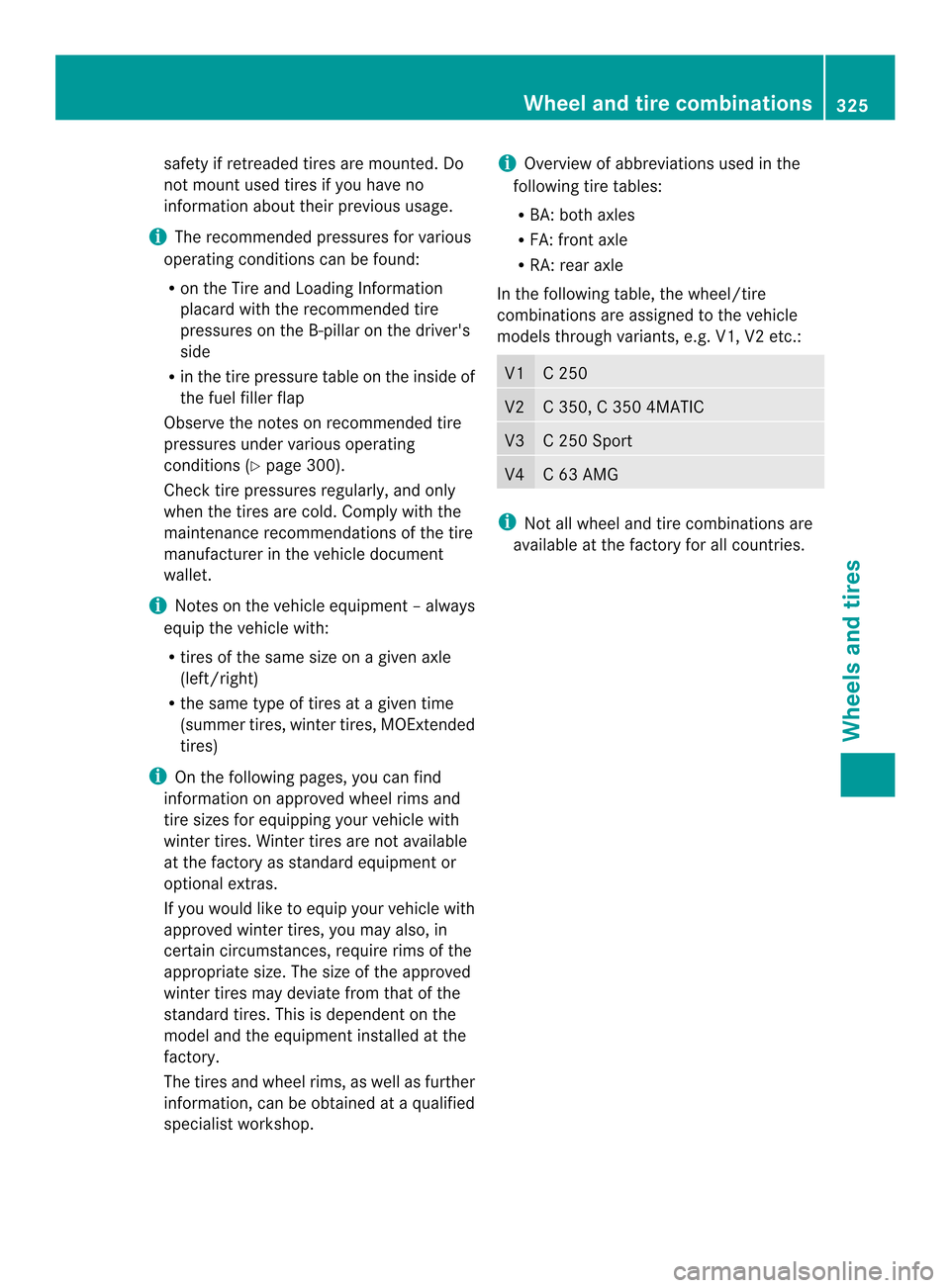
safety if retreaded tires are mounted. Do
not mount used tires if you have no
information aboutt heir previous usage.
i The recommended pressures for various
operating conditions can be found:
R on the Tire and Loading Information
placard with the recommended tire
pressures on the B-pillar on the driver's
side
R in the tire pressure table on the inside of
the fuel filler flap
Observe the notes on recommended tire
pressures under various operating
conditions (Y page 300).
Check tire pressures regularly, and only
when the tires are cold. Comply with the
maintenance recommendations of the tire
manufacturer in the vehicle document
wallet.
i Notes on the vehicle equipment –always
equip the vehicle with:
R tires of the same size on a given axle
(left/right)
R the same type of tires at a given time
(summer tires, winter tires, MOExtended
tires)
i On the following pages, you can find
information on approved wheel rims and
tire sizes for equipping your vehicle with
winter tires. Winter tires are not available
at the factory as standard equipmen tor
optional extras.
If you would like to equip your vehicle with
approved winter tires, you may also, in
certain circumstances, require rims of the
appropriate size. The size of the approved
winter tires may deviate from that of the
standard tires. This is dependent on the
model and the equipment installed at the
factory.
The tires and wheel rims, as well as further
information, can be obtained at a qualified
specialist workshop. i
Overview of abbreviations used in the
following tire tables:
R BA: both axles
R FA: front axle
R RA: rear axle
In the following table, the wheel/tire
combinations are assigned to the vehicle
models through variants, e.g. V1, V2 etc.: V1 C 250
V2 C 350, C 350 4MATIC
V3 C 250 Sport
V4 C 63 AMG
i
Not all wheel and tire combinations are
available at the factory for all countries. Wheel and tire combinations
325Wheels and tires Z
Page 328 of 342
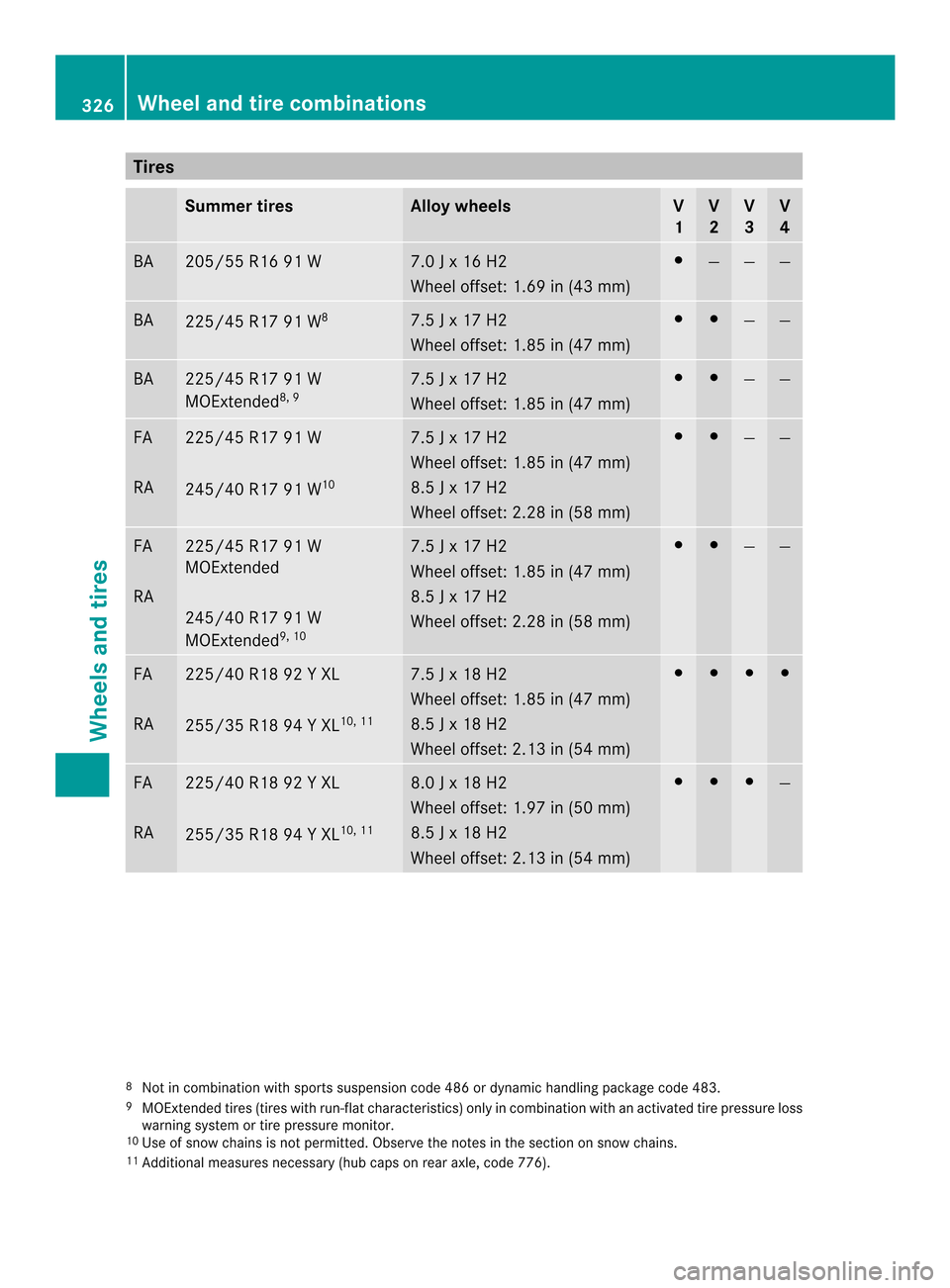
Tires
Summer tires Allo
ywheels V
1 V
2 V
3 V
4 BA 205/55 R16 91 W 7.0 J x 16 H2
Wheel offset: 1.69 in (43 mm) 001C
— — —
BA
225/45 R17 91 W
8 7.5 J x 17 H2
Wheel offset: 1.85 in (47 mm) 001C 001C
— —
BA 225/45 R17 91 W
MOExtended
8, 9 7.5 J x 17 H2
Wheel offset: 1.85 in (47 mm) 001C 001C
— —
FA
RA 225/45 R17 91 W
245/40 R17 91 W
10 7.5 J x 17 H2
Wheel offset: 1.85 in (47 mm)
8.5 J x 17 H2
Wheel offset: 2.28 in (58 mm) 001C 001C
— —
FA
RA 225/45 R17 91 W
MOExtended
245/40 R17 91 W
MOExtended
9, 10 7.5 J x 17 H2
Wheel offset: 1.85 in (47 mm)
8.5 J x 17 H2
Wheel offset: 2.28 in (58 mm) 001C 001C
— —
FA
RA 225/40 R18 92 Y XL
255/35 R18 94 Y XL
10, 11 7.5 J x 18 H2
Wheel offset: 1.85 in (47 mm)
8.5 J x 18 H2
Wheel offset: 2.13 in (54 mm) 001C 001C 001C 001C
FA
RA 225/40 R18 92 Y XL
255/35 R18 94 Y XL
10, 11 8.0 J x 18 H2
Wheel offset: 1.97 in (50 mm)
8.5 J x 18 H2
Wheel offset: 2.13 in (54 mm) 001C 001C 001C
—
8
Not in combination with sports suspension code 486 or dynamic handling package code 483.
9 MOExtended tires (tires with run-fla tcharacteristics) only in combination with an activated tire pressure loss
warning system or tire pressure monitor.
10 Use of snow chains is not permitted. Observe the notes in the section on snow chains.
11 Additional measures necessary (hub caps on rear axle, code 776). 326
Wheel and tire combinationsWheels and tires
Page 329 of 342
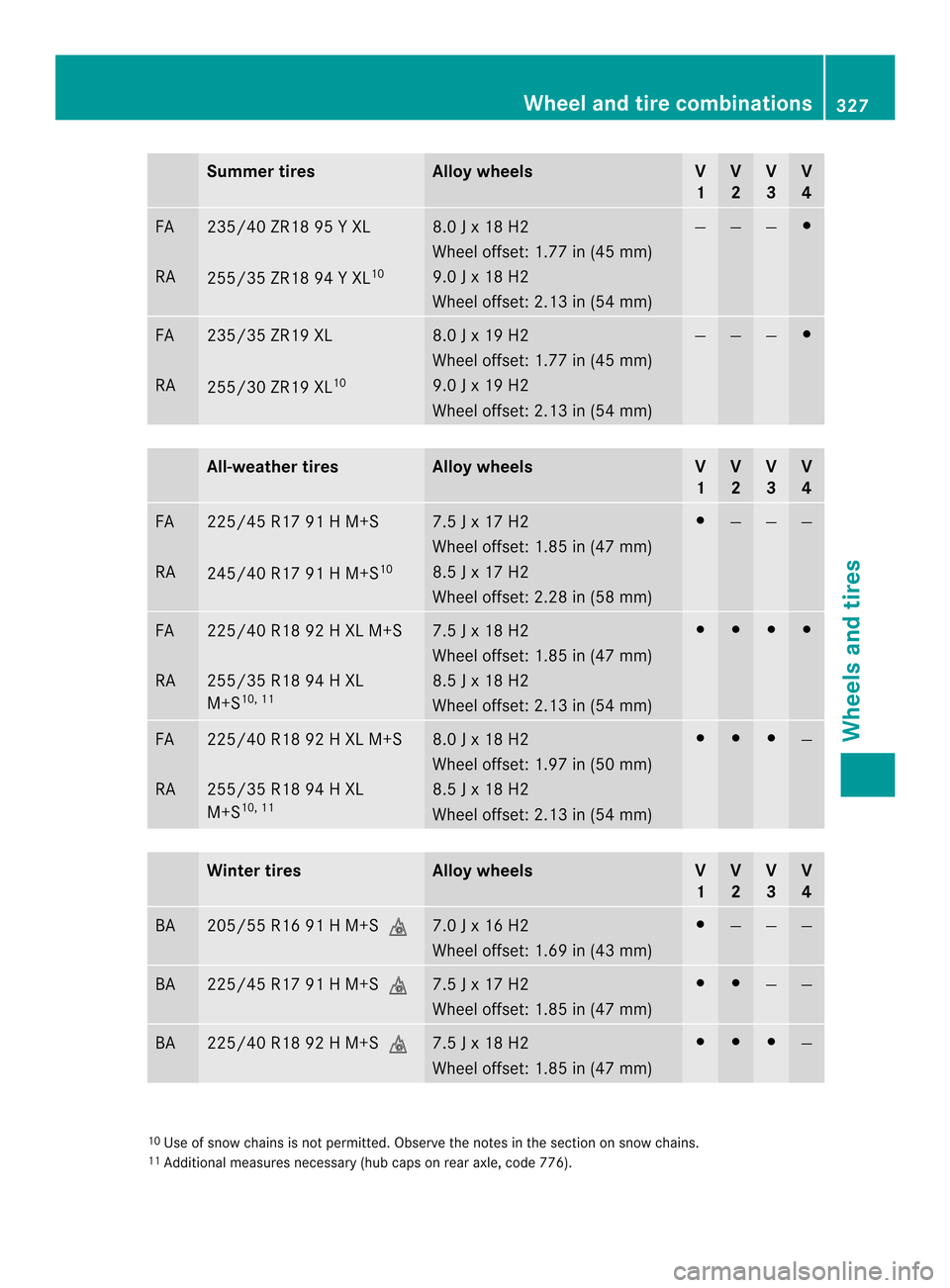
Summer tires Alloyw
heels V
1 V
2 V
3 V
4 FA
RA 235/40 ZR18 95
YXL
255/35 ZR18 94 YXL10 8.0 J x 18 H2
Wheel offset: 1.77 in (45 mm)
9.0 J x 18 H2
Wheel offset: 2.13 in (54 mm) — — — 001C
FA
RA 235/35 ZR19 XL
255/30 ZR19 XL
10 8.0 J x 19 H2
Wheel offset: 1.77 in (45 mm)
9.0 J x 19 H2
Wheel offset: 2.13 in (54 mm) — — — 001C
All-weathe
rtires Alloy wheels V
1 V
2 V
3 V
4 FA
RA 225/45 R17 91 H M+S
245/40 R17 91 H M+S
10 7.5 J x 17 H2
Wheel offset: 1.85 in (47 mm)
8.5 J x 17 H2
Wheel offset: 2.28 in (58 mm) 001C
— — —
FA
RA 225/40 R18 92 H XL M+S
255/35 R18 94 H XL
M+S
10, 11 7.5 J x 18 H2
Wheel offset: 1.85 in (47 mm)
8.5 J x 18 H2
Wheel offset: 2.13 in (54 mm) 001C 001C 001C 001C
FA
RA 225/40 R18 92 H XL M+S
255/35 R18 94 H XL
M+S
10, 11 8.0 J x 18 H2
Wheel offset: 1.97 in (50 mm)
8.5 J x 18 H2
Wheel offset: 2.13 in (54 mm) 001C 001C 001C
—
Winter tires Alloy wheels V
1 V
2 V
3 V
4 BA 205/55 R16 91 H M+S
0002 7.0 J x 16 H2
Wheel offset: 1.69 in (43 mm) 001C
— — —
BA 225/45 R17 91 H M+S
0002 7.5 J x 17 H2
Wheel offset: 1.85 in (47 mm) 001C 001C
— —
BA 225/40 R18 92 H M+S
0002 7.5 J x 18 H2
Wheel offset: 1.85 in (47 mm) 001C 001C 001C
—
10
Use of snow chains is not permitted. Observe the notes in the section on snow chains.
11 Additional measures necessary (hub caps on rear axle, code 776). Wheel and tire combinations
327Wheels and tires Z
Page 330 of 342
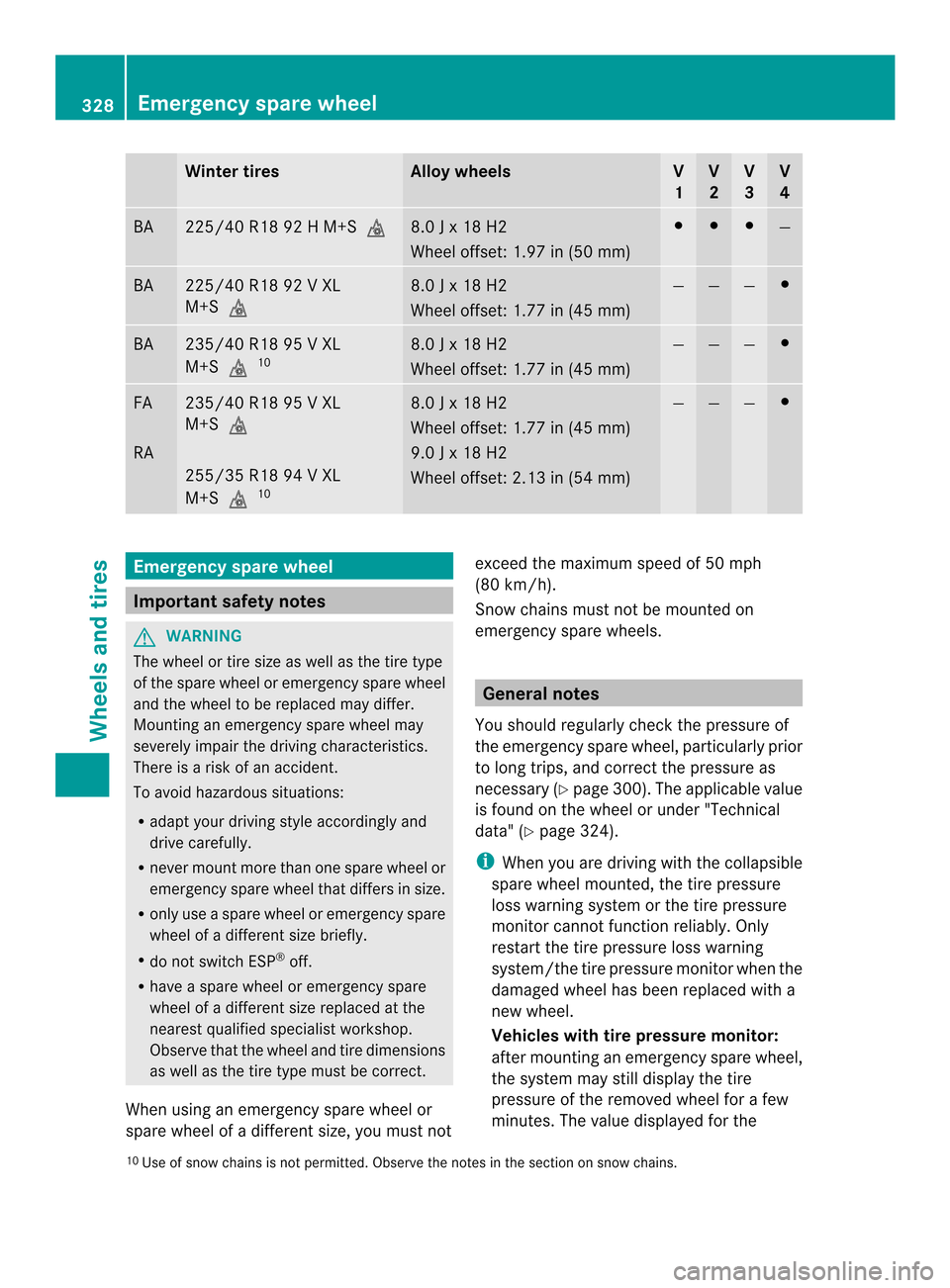
Winter tires Alloy wheels V
1 V
2 V
3 V
4 BA 225/40 R18 92 H M+S0002 8.0 J x 18 H2
Wheel offset: 1.97 in (50 mm) 001C 001C 001C
—
BA 225/40 R18 92 V XL
M+S0002 8.0 J x 18 H2
Wheel offset: 1.77 in (45 mm) — — — 001C
BA 235/40 R18 95 V XL
M+S0002
10 8.0 J x 18 H2
Wheel offset: 1.77 in (45 mm) — — — 001C
FA
RA 235/40 R18 95 V XL
M+S0002
255/35 R18 94 V XL
M+S0002
10 8.0 J x 18 H2
Wheel offset: 1.77 in (45 mm)
9.0 J x 18 H2
Wheel offset: 2.13 in (54 mm) — — — 001C
Emergency spare wheel
Important safety notes
G
WARNING
The wheel or tire size as well as the tire type
of the spare wheel or emergency spare wheel
and the wheel to be replaced may differ.
Mounting an emergency spare wheel may
severely impair the driving characteristics.
There is a risk of an accident.
To avoid hazardous situations:
R adapt you rdriving style accordingly and
drive carefully.
R never mount more than one spare wheel or
emergency spare wheel that differs in size.
R only use a spare wheel or emergency spare
wheel of a different size briefly.
R do not switch ESP ®
off.
R have a spare wheel or emergency spare
wheel of a different size replaced at the
nearest qualified specialist workshop.
Observe that the wheel and tire dimensions
as well as the tire type must be correct.
When using an emergency spare wheel or
spare wheel of a different size, you must not exceed the maximum speed of 50 mph
(80 km/h).
Snow chains must not be mounted on
emergency spare wheels. General notes
You should regularly check the pressure of
the emergency spare wheel, particularly prior
to long trips, and correct the pressure as
necessary (Y page 300). The applicable value
is found on the wheel or under "Technical
data" (Y page 324).
i When you are driving with the collapsible
spare wheel mounted, the tire pressure
loss warning system or the tire pressure
monitor cannot function reliably. Only
restart the tire pressure loss warning
system/the tire pressure monitor when the
damaged wheel has been replaced with a
new wheel.
Vehicles with tire pressure monitor:
after mounting an emergency spare wheel,
the system may still display the tire
pressure of the removed whee lfor a few
minutes. The value displayed for the
10 Use of snow chains is not permitted. Observe the notes in the section on snow chains. 328
Emergency spare wheelWheels and tires